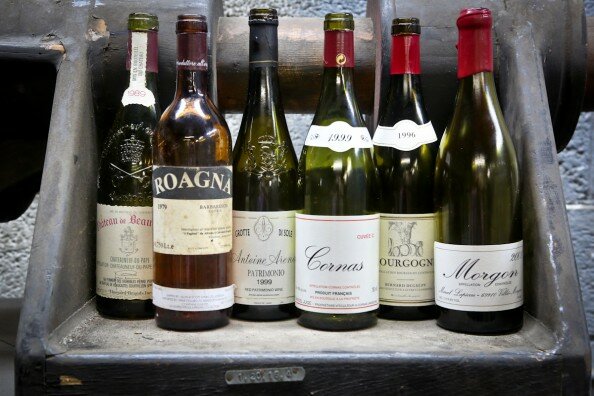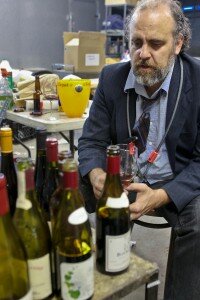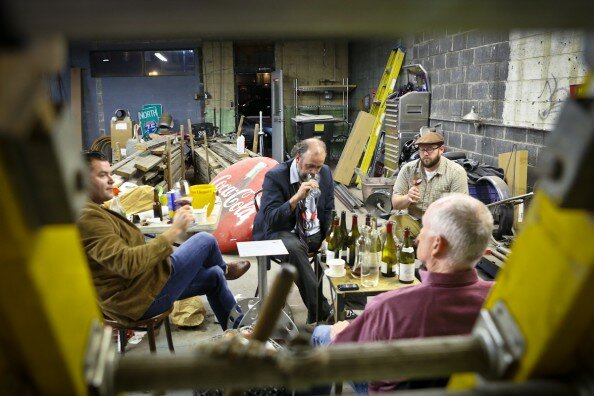
Monthly Archives: November 2012
Gourmet Underground Detroit's content archives are organized by date and catalog the aggregated content of our Features pages as well as our blog.
Tasting Notes from the Cellar

There are lots of ways to put together a collection of older wines. Collect and store them in a cellar, buy them from a reputable merchant who has stored them, steal them from a friend, find a store that has found a so-called library release of wines aged at the winery, et cetera. Each of these methods (Except stealing. I think.) were put to use a couple weeks back when a group of us got together to drank some older wines.
A few notes, recorded for posterity’s sake…
1979 Roagna Barbaresco
Delicious from the start, this might have been my favorite wine of the evening, opening up to a beautifully tart and fruity wine with very noticeable spicy and herbal undertones. Tarragon? Mint? Tobacco? Umami? A really nuanced wine that moved from being a bit tannic to downright light and lively. As Todd said, the “most complete wine” of the evening.
1989 Beaucastel, Chateauneuf de Pape
Earthy and big to start, it finished with an edge that smoothed out and opened up over time. A little funk early on that blew off quickly. Lots of fruit, though, even from the onset. Steve observed it might be on the downside of its life. But after a couple of hours, the leather and tannin subsided a bit. Pretty classic; a fine drink.
1999 Antoine Arena, Patrimonio
Dark, deeply colored, full of sediment, brooding aromas to start. Dirty, tannic, earthy wine. Some minerality and acid. Looks brooding, full of flavor, but surprisingly youthful. I wish I’d taken more detailed notes, but the general sentiment was that this was in a good place. Steve observed in retrospect that it was hard to wrap his head around this, and I agree: It was the biggest of the all and came late in a long night of drinking.
1990 Bongran Macon Clesse
 Remarkably unique. Truly. Drew a chorus of quizzical looks and comments. Todd described the aromatics as being a lot like coffee beans, and Putnam began to latch onto that as a descriptor for the flavor as well. I think I see what they were getting at in terms of a the long, slow, earthy quality of the fruit. Floral and honey notes. Not sweet but clearly botrytized grapes. Lots of tropical fruit but not of the predictable sort found in so many overly engineered wines. Some in the group felt it would be hard to drink this in any serious quantities, me among them, but it’s hard to deny its brilliance.
Remarkably unique. Truly. Drew a chorus of quizzical looks and comments. Todd described the aromatics as being a lot like coffee beans, and Putnam began to latch onto that as a descriptor for the flavor as well. I think I see what they were getting at in terms of a the long, slow, earthy quality of the fruit. Floral and honey notes. Not sweet but clearly botrytized grapes. Lots of tropical fruit but not of the predictable sort found in so many overly engineered wines. Some in the group felt it would be hard to drink this in any serious quantities, me among them, but it’s hard to deny its brilliance.
1996 Dugat-Py Bourgogne Rouge
I wonder what this cost on release. No famed crus on the label. Just good wine in the bottle that has lasted until now. Light, refreshing, but still structured. As Putt said, it’s “chuggable.” Of course, Putt thinks whiskey is “chuggable.” But still, I tend to agree. We also had a 1995 Marechal Pommard, and the Dugat-Py was in a far better place. The other was gnarled and dare I say backward whereas this was simply pretty.
1999 Juge Cuvee C Cornas
Coming after a puckeringly tart Morgon and even the Chateauneuf, this was downright jammy. Young and fruity. A nice dose of acid, but compared to other wines, this really seemed sweet. Delicious but didn’t really suck me in the way some others did.

Chateau Thivin Cote de Brouilly: Why This $20 Wine is Better
I’m always trying to sniff out bottles of wine that supply the most gratifying drinking experience for the price. Some people call these “value wines”.
But it ain’t easy.
The vast majority of wine under $10/bottle is made to be consumed immediately and with little fanfare. In this price range you’re going to find a lot of idyllic back label stories that read like tourist guides to the Elysium Fields. The truth is — and here you can make an honest comparison to the realm of domestic beer — as many beer-only drinkers find their ice-cold American lager brand of choice to be a flawless beverage no matter what the situation, some wine drinkers will swear by $6 bottles of perfectly unremarkable chardonnay. That’s fine if you just want to catch a buzz.
At a local Indian restaurant that “allows” BYOB, I watched as a threesome were seated and one of their party subsequently pulled out a bottle of white zinfandel and two cans of Busch Light from his jean jacket. It seems to me that if you’re going to surrender your taste buds to the relatively exotic flavors of the Indian Subcontinent, you ought to at least have a simple Riesling or a malty Pilsener to wash it all down. This merely illustrates that most of the time familiarity rules — especially when the price is right.
You can find a wine with character for $10-$15. A value wine. One that pops into mind is Domaine de la Fruitière Chardonnay. Here is a dry, white wine that probably won’t change your philosophy but it does combine the richness of chardonnay with the crisp mineral structure of traditional Muscadet, and when slightly chilled, drinks agreeably in the shade of an oak tree near your favorite swimming hole on a warm July day. If you’re one of those aforementioned, strict chardonnay drinkers, here is a risk-free way to expand your palate.
If you are a wine enthusiast with a limited budget and a desire to learn, the $15-$25 range is ripe with good wine of character. This is your sweet spot. Unfortunately, there is also a lot of ordinary wine with large brand marketing budgets in this group. A trustworthy wine merchant is vital to lead the way here.
The trustworthy wine merchant is going to carry things like Château Thivin Côte de Brouilly for a little less than $25. But what makes this particular wine better? Why is it three times the price of Yellow Tail merlot?
The reasons are many. For one, it’s drinkable. I have consumed at least a half dozen bottles of this wine in the past few months with different people. With the exception of one person that was exceedingly sensitive to tannins, we all loved it. But drinkable does not mean simple. A glassful is all berries and flowers and wet stones. It’s tart and refreshing, with a minerality that grips at the finish. There is an integration of aromas, textures and flavors that elevate this wine well above the grocery store bottles. In short, it tastes like more than just fermented fruit juice.
Secondly, it’s from somewhere. Part of the pleasure derived from fine wine is creating a connection to a place. In this case we can identify it from the Beaujolais winemaking region of France. Further, it is from Brouilly, one of ten Cru Beaujolais, (the highest category of classification in the region). Even further, this wine is from vineyards in the sub-district of Côte de Brouilly, from the steep slopes of Mont Brouilly, where the soil is composed of volcanic blue stone. It’s kind of like one of those international espionage movies that zoom into a spot on earth from a satellite camera in orbit, except we witness a grape farmer tending his vines, not the assassination of a high level diplomat.
And finally, for the enthusiast, it’s educational. Compare this wine to other Cru Beaujolais in the same price range. Because all are made from gamay grapes, you begin to get a sense of how climate and soil can affect the finished wine (terrior!). And because Cru Beaujolais can sometimes develop over three to ten years, you can afford to let a few of these sit in the cellar and see how they change with time.
A typical question from wine novices when confronted with wine prices ranging from $3 to $300 is: Do you get what you pay for? I’ve struggled with this question myself after I decided I that I really, really like wine. A lot. And I still struggle. The general answer is complex and can include things like hand-harvesting, barrel-aging. Both of which are applied to Château Thivin Côte de Brouilly. So, in this case, I believe it’s a resounding yes. Buy some and invite me over for drinks.
